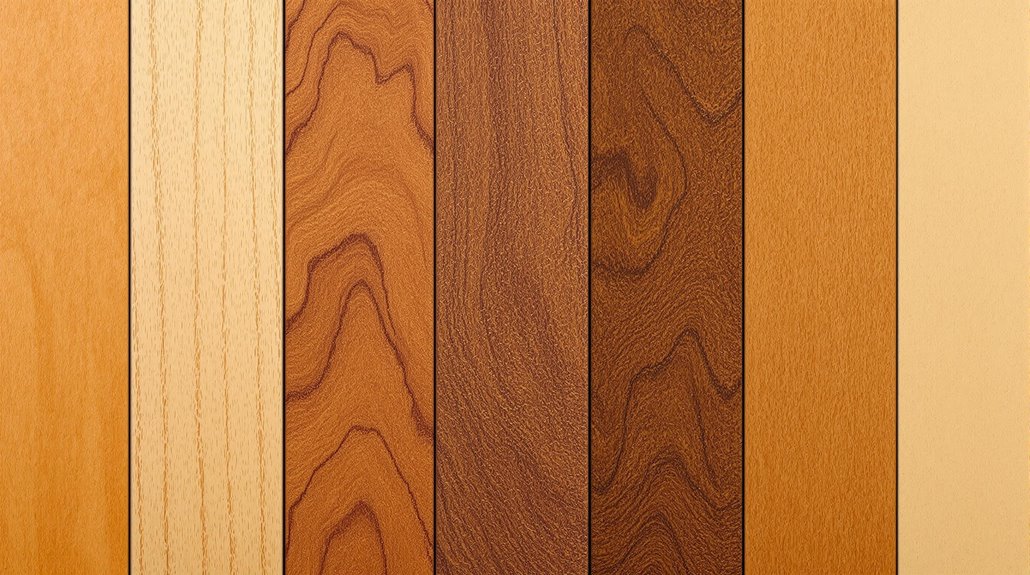The prettiest wood types are often identified by their unique grain patterns, colors, and textures. For instance, walnut showcases a rich spectrum from light to dark brown, while mahogany deepens in hue over time. Maple and cherry present a straight grain that offers a sleek, uniform appearance. Curly maple and figured mahogany introduce distinctive decorative irregularities. Additionally, woods like birch feature smooth finishes, further enhancing their visual appeal. Ultimate selection often combines aesthetic qualities with functionality. Understanding various wood types can help one appreciate their beauty and utility in different applications, prompting further exploration of this topic.
Aesthetic Appeal of Wood Grain
While the aesthetic appeal of wood grain can vary considerably across different species, each type offers unique patterns and textures that enhance the character of furniture and decorative objects. Straight grain, commonly found in maple and cherry, provides a clean and uniform appearance, ideal for modern designs. In contrast, figured grain, seen in curly maple and mahogany, introduces decorative irregularities that draw attention. Birdseye grain, with its distinctive round knots, adds a unique charm, while quilted grain offers a luxurious texture reminiscent of fabric. Cross grain, characterized by angled fibers, creates a dynamic visual effect. Understanding these patterns allows designers and craftsmen to select wood that aligns with their aesthetic vision, ensuring that each piece resonates with its intended environment.
Popularity and Versatility
The popularity of various wood types can be attributed to their distinctive grain characteristics and functional applications across multiple styles. For example, European Oak is favored for its strength and stability in flooring, while Maple is sought after for its versatility, commonly used in everything from furniture to bowling pins. Each wood type not only serves practical purposes but also contributes aesthetically to design, making them valuable in both residential and commercial settings.
Commonly Used Woods
Wood species play a pivotal role in both aesthetic appeal and functional performance across various applications. Among the most popular hardwoods, European Oak is prized for its durability and resistance to environmental changes, making it ideal for flooring. White Oak, with its light coloration and strength, is versatile for both flooring and construction. Red Oak offers a warm hue and ease of staining, though it is less moisture-resistant. Maple, known for its hardness and fine grain, is widely used in flooring and specialized items like bowling pins. Hickory stands out for its resilience in high-traffic areas, while Walnut, with its rich tones, is favored for furniture and cabinetry, showcasing the diverse applications and popularity of these hardwoods.
Unique Grain Characteristics
When considering the aesthetic impact and versatility of various hardwoods, unique grain characteristics emerge as a defining feature that enhances their appeal. Oak features a prominent grain pattern that can be described as straight, open, or coarse, with distinctive ray fleck adding depth. Mahogany showcases an interlocked grain, creating a ribbon-like effect that exudes elegance. Walnut presents a striking figure, ranging from straight to wavy, with burls that introduce irregular patterns and a rich, dark hue. Cherry is notable for its fine, straight grain that may vary, producing unique designs over time as its color deepens. These diverse grain characteristics contribute greatly to the popularity and versatility of these woods in various applications.
Functional Applications and Styles
Unique grain characteristics not only contribute to the visual appeal of hardwoods but also influence their functional applications across various styles. For instance, oak's strength makes it a preferred choice in furniture making and construction, while maple's versatility allows it to shine in high-end furniture and musical instruments. Cherry's rich aging process enhances its desirability for cabinetry, whereas cedar's weather resistance suits outdoor applications. In decorative uses, European walnut is celebrated for its aesthetic charm, while boxwood's fine grain is ideal for intricate inlays. Additionally, specialized uses for woods like hornbeam in tool making highlight the diverse functional properties of these materials, showcasing their adaptability across both practical and artistic domains.
Durability and Strength
Durability and strength are critical factors in selecting wood types for various applications, particularly in environments subject to harsh conditions. Very durable woods, such as Teak, can withstand direct ground contact for over 25 years, exhibiting exceptional resistance to decay and marine organisms. Durable woods last approximately 15 to 25 years, while moderately durable options offer a lifespan of 10 to 15 years. Non-durable types, like certain bamboo species, may only last 6 months to 3 years. The Janka hardness test further evaluates strength, with hardwoods like Hickory and Brazilian Cherry demonstrating high resistance to dents. Additionally, woods such as Suriname Ironwood showcase remarkable crushing strength, ensuring resilience against compression, highlighting the importance of selecting appropriate wood types for specific applications.
Workability and Ease of Use
The workability of various wood types greatly influences their suitability for detailed projects, particularly in shaping with hand tools and the ease of finishing and sanding. Hardwoods like birch and maple, while providing a smooth finish, require sharp tools to manage their density, whereas softwoods like cedar and pine offer a more user-friendly experience due to their lighter weight and softness. Understanding the characteristics of each wood type is essential for selecting the right material for specific applications, ensuring both efficiency in crafting and quality in the final product.
Shaping With Hand Tools
While various wood types offer distinct characteristics, their workability and ease of shaping with hand tools greatly influence the choice of material for specific projects. Basswood stands out for its softness, making it exceptionally easy to carve and shape, ideal for detailed work and intricate carvings. Birch, though moderately hard, provides a uniform appearance that facilitates consistent shaping, suitable for turning and specialty items. Beech, while strong, requires sharp tools due to its brittleness, posing challenges for long pieces. Eastern White Pine, appreciated for its stability, cuts and planes with minimal resistance, making it a favored choice for beginners. Each wood type presents unique advantages, allowing craftsmen to select materials that align with their project requirements.
Finishing and Sanding Ease
When selecting wood for a project, the ease of finishing and sanding plays an essential role in achieving a high-quality appearance. Hardwoods, known for their density and durability, often yield smoother finishes, especially closed grain varieties like maple and cherry. However, their density can make them more challenging to work with, requiring specialized tools. In contrast, softwoods are more forgiving, easier to manipulate, and generally more affordable, though they may exhibit visible knots and less durability. When sanding, starting with appropriate grits—such as 80 or 120—followed by progressively finer grits is vital. Proper surface preparation and technique, including sanding in the grain direction, enhance the final finish, ensuring lasting beauty and performance in the selected wood type.
Unique Features and Figures
Uniquely engaging, various wood types showcase a remarkable array of features and figures that enhance their appeal in both aesthetic and functional applications. For instance, African Padauk captivates with its vibrant reddish-orange hue that deepens over time, while Mahogany presents a rich reddish-brown color paired with distinctive grain patterns, including an interlocked ribbon-like effect. Similarly, Canary wood exhibits a spectrum of colors and eye-catching patterns, making it particularly versatile. Katalox stands out with deep purples and rich browns, whereas Desert Ironwood boasts dark brown shades accented by striking black streaks. The durability of these woods, such as Black Locust's decay resistance and Mopane's density, further augments their desirability, making them suitable for a wide range of applications.
Environmental Considerations
As the demand for wood products continues to rise, understanding the environmental considerations surrounding wood sourcing becomes increasingly critical. Deforestation poses significant threats, leading to habitat destruction and biodiversity loss, with an estimated 1,000 species becoming extinct annually. Moreover, the removal of trees diminishes carbon sequestration capacity, releasing stored carbon into the atmosphere and exacerbating climate change. Conversely, sustainable wood harvesting practices, which involve managed forest land, can mitigate these issues. These practices guarantee healthy regrowth and maintain wildlife habitats while adhering to Best Management Practices (BMPs) that protect air, water, and soil. Sustainable wood types, such as Douglas fir and tulipwood, also have lower carbon footprints during production, making them more environmentally friendly options for consumers.
Choosing the Right Wood
Selecting the appropriate wood for a project is essential to achieving both aesthetic and functional goals. Different wood types offer unique color variations and grain patterns that can enhance the visual appeal of any item. For instance, walnut presents a spectrum from light to dark brown, while mahogany deepens in hue over time. Durability is equally critical; hardwoods like teak are renowned for their resistance to moisture, making them ideal for outdoor use. Budget considerations also play a role, as exotic hardwoods tend to be pricier due to their rarity. Additionally, the specific use of the wood, whether for furniture or flooring, can dictate the choice; oak remains a popular option for its strength and stability in various applications.

